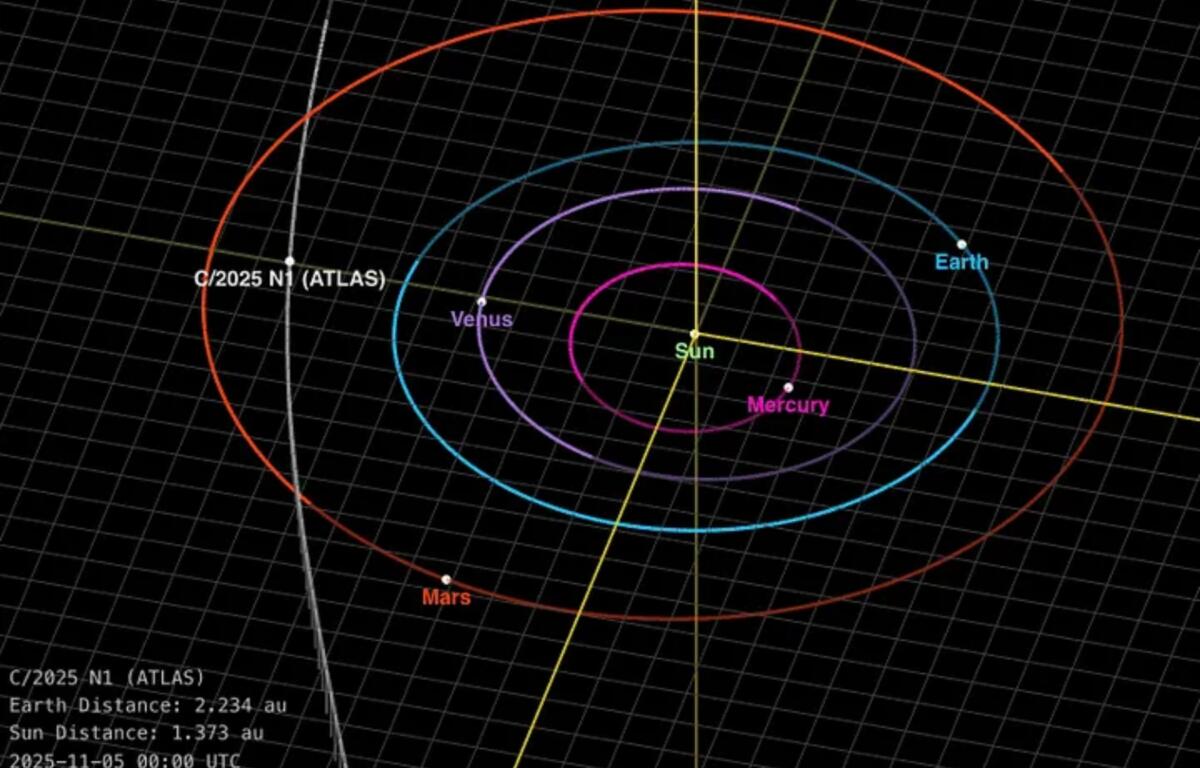ASHEVILLE, N.C. (828newsNOW) — If you’ve scrolled Facebook lately, you may have seen talk of 3I/ATLAS — a fast-moving object some claim could be a spaceship. But astronomers say it’s nothing more than a natural visitor from another star system.
According to NASA, comet 3I/ATLAS is the third known interstellar object ever detected passing through our solar system. It shows slight “non-gravitational acceleration,” a normal effect seen in comets as jets of gas push them while they approach the Sun.
“There is no serious scientific consideration that comet 3I/ATLAS could be anything other than a natural object,” said Dr. Luis Agustín Chavarría Garrido, visiting astronomer at UNC Asheville.
Its discovery is exactly what the ATLAS (Asteroid Terrestrial-impact Last Alert System) survey telescope was designed to do — identify and track small objects moving through our solar system, he said.

“This is not the first interstellar object that we have detected. In fact, the name 3I comes from I: Interstellar and 3 because it is the third object of its type detected so far,” he explained. “Discoveries like this are becoming more frequent as our technology improves.”
A harmless interstellar visitor
NASA reports that 3I/ATLAS poses no threat to Earth. The comet will remain about 170 million miles from our planet at its closest approach.
The object was first detected July 1, 2025, by the Asteroid Terrestrial-impact Last Alert System (ATLAS) telescope in Rio Hurtado, Chile. Additional “pre-discovery” images were later found in data from observatories around the world, including Caltech’s Zwicky Transient Facility in California.
Chavarría said the comet’s high velocity confirmed it was not from our solar system.
“That tells us that it doesn’t belong to our solar system,” he said. “Each discovery helps us understand more about the diversity of planetary systems beyond our own.”
Surprising observations
Professor Abraham (Avi) Loeb, Frank B. Baird Jr. Professor of Science at Harvard University and director of the Institute for Theory & Computation, noted some unusual features in the comet’s behavior.
“There should have been a very massive cloud of gas and dust around it, like other comets,” Loeb said. “But 3I/ATLAS looks like a fuzzy ball of light. Even after perihelion, it was heated, and the gas — mostly carbon dioxide — should have created a huge tail, but we don’t see that.”
Loeb suggested one possibility: fragments of ice may vaporize before forming a visible plume, explaining the comet’s unusual appearance. He also noted a recent blue color and a fivefold increase in brightness.
“There are things we don’t fully understand about this object, which makes it exciting,” Loeb said in a recent social media post. “We’ll wait for new data in the coming weeks, especially around Dec. 19, when it comes closest to Earth. But six days before Christmas, let’s hope we don’t get unwanted gifts for our holidays.”

No ‘planetary defense’ protocols activated
NASA and Harvard’s Minor Planet Center, which monitor near-Earth objects, determined early on that 3I/ATLAS’s trajectory was harmless.
“From the first observations, it was immediately clear that it would not come anywhere near Earth,” Chavarría said. “Data showed right away that 3I/ATLAS is on a harmless path.”
A NASA spokesperson agreed 3I/ATLAS posed no risk to Earth.
“3I/ATLAS has all the hallmarks of a comet. It has been emitting dust and gas at increasing rates as it has neared and been warmed by the Sun. All of the evidence strongly indicates that it is a comet,” the spokesperson said. “3I/ATLAS is passing through our Solar System on the opposite side of the Sun from where Earth is now. 3I/ATLAS poses no risk to Earth.”
Fake images circulate online
Some viral posts have shared fabricated images claiming to show 3I/ATLAS as a “spacecraft.” NASA officials confirmed those pictures are not authentic.
“The true scientific images show a diffuse, glowing cloud of gas and dust, just like we expect from any normal comet when sunlight heats it up and causes ice to sublimate. It’s completely normal for comets to look somewhat unusual in photos, especially when their shape changes as they get closer to the Sun. But that doesn’t make them artificial or technological in nature,” Chavarría said.
He said many of the images posted online come from websites that promote conspiracy theories and misinformation about UFOs and supposed “alien technology.” None of those claims are supported by scientific evidence, he said.
Verified photos and details can be found through NASA and the European Space Agency’s Hubble site at science.nasa.gov and esahubble.org.
What’s next for 3I/ATLAS
A NASA spokesperson said the agency will continue observing the comet as it moves through the solar system.
“3I/ATLAS has all the hallmarks of a comet,” the NASA spokesperson said. “It’s emitting dust and gas as it nears the Sun. All the evidence strongly indicates it is a comet.”
The comet is now visible with basic viewing equipment, such as small telescopes or good binoculars, after re-emerging from behind the Sun. The interstellar comet is currently visible in the predawn sky near the constellation Virgo.
Each of these interstellar comets is like a messenger from another part of our galaxy, Chavarría said.
“By studying its composition and trajectory, we can learn more about how other planetary systems form and evolve,” he said.


